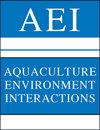Farmed salmonids drive the abundance, ecology and evolution of parasitic salmon lice in Norway
IF 2.5
2区 农林科学
Q2 FISHERIES
引用次数: 18
Abstract
Sea cage fish farming is typically open to the environment, with disease transmission possible between farmed and wild hosts. In salmonid aquaculture, salmon louse Lepeophtheirus salmonis infestations cause production losses, reduce welfare for farmed fish and increase infestation rates for wild fish populations. The high density of hosts in farms likely also shifts the coevolutionary arms race between host and parasite, with ecological and evolutionary consequences for the salmon louse. Using farm-reported salmon and louse abundances and publicly reported estimates of wild salmonid host abundances and the salmon lice they carry, we estimated (1) the relative abundance of farmed and wild salmonid hosts and (2) the relative importance of each for the abundance of salmon lice for the coastal zone of Norway from 1998 to 2017. Farmed hosts increased in importance over time with the expansion of the industry. From 2013 to 2017, farmed salmonids outnumbered wild salmonids by 267−281:1. By 2017, farmed salmonids accounted for 99.6% of available hosts and produced 99.1% of adult female salmon lice and 97.6% of mated (ovigerous) adult female salmon lice in Norwegian coastal waters. The persistent dominance of farmed hosts has clear implications: (1) management decisions that aim to limit lice abundance can be guided by lice data from farms alone, as lice on wild salmonids make a trivial contribution to the national lice population; and (2) strategies to prevent or treat lice infestations are vulnerable to the evolution of resistance, as the pool of wild hosts is inconsequential and will not act as a refuge large enough to stem the evolution of resistance. As the Norwegian salmon industry expands and salmon lice infestations continue, farmed salmon will drive the ecology and evolution of salmon lice.养殖鲑鱼推动了挪威寄生鲑鱼虱的丰富、生态和进化
海网箱养鱼通常对环境开放,疾病可能在养殖和野生宿主之间传播。在鲑科水产养殖中,鲑鱼虱(Lepeophtheirus salmonis)侵染造成生产损失,降低养殖鱼类的福利,并增加野生鱼类种群的侵染率。农场中高密度的宿主可能也改变了宿主和寄生虫之间的共同进化军备竞赛,对鲑鱼虱产生了生态和进化后果。利用养殖场报告的鲑鱼和虱的丰度,以及公开报告的野生鲑鱼宿主丰度和它们携带的鲑鱼虱的估计,我们估计了(1)1998年至2017年挪威沿海地区养殖鲑鱼和野生鲑鱼宿主的相对丰度,(2)每种宿主对鲑鱼虱丰度的相对重要性。随着时间的推移,随着行业的扩张,养殖宿主的重要性也在增加。从2013年到2017年,养殖鲑科鱼类的数量与野生鲑科鱼类的数量之比为267比281。到2017年,在挪威沿海水域,养殖鲑鱼占可用宿主的99.6%,产生了99.1%的成年雌性鲑鱼虱和97.6%的交配(产卵)成年雌性鲑鱼虱。养殖寄主的持续优势具有明确的含义:(1)旨在限制虱子数量的管理决策可以仅以来自农场的虱子数据为指导,因为野生鲑鱼上的虱子对全国虱子数量的贡献微不足道;(2)预防或治疗虱子侵扰的策略很容易受到抗药性进化的影响,因为野生宿主的数量微不足道,不能作为一个足够大的避难所来阻止抗药性的进化。随着挪威鲑鱼产业的扩张和鲑鱼虱的持续侵扰,养殖鲑鱼将推动鲑鱼虱的生态和进化。
本文章由计算机程序翻译,如有差异,请以英文原文为准。
求助全文
约1分钟内获得全文
求助全文
来源期刊

Aquaculture Environment Interactions
FISHERIES-MARINE & FRESHWATER BIOLOGY
CiteScore
4.90
自引率
13.60%
发文量
15
审稿时长
>12 weeks
期刊介绍:
AEI presents rigorously refereed and carefully selected Research Articles, Reviews and Notes, as well as Comments/Reply Comments (for details see MEPS 228:1), Theme Sections and Opinion Pieces. For details consult the Guidelines for Authors. Papers may be concerned with interactions between aquaculture and the environment from local to ecosystem scales, at all levels of organisation and investigation. Areas covered include:
-Pollution and nutrient inputs; bio-accumulation and impacts of chemical compounds used in aquaculture.
-Effects on benthic and pelagic assemblages or processes that are related to aquaculture activities.
-Interactions of wild fauna (invertebrates, fishes, birds, mammals) with aquaculture activities; genetic impacts on wild populations.
-Parasite and pathogen interactions between farmed and wild stocks.
-Comparisons of the environmental effects of traditional and organic aquaculture.
-Introductions of alien species; escape and intentional releases (seeding) of cultured organisms into the wild.
-Effects of capture-based aquaculture (ranching).
-Interactions of aquaculture installations with biofouling organisms and consequences of biofouling control measures.
-Integrated multi-trophic aquaculture; comparisons of re-circulation and ‘open’ systems.
-Effects of climate change and environmental variability on aquaculture activities.
-Modelling of aquaculture–environment interactions; assessment of carrying capacity.
-Interactions between aquaculture and other industries (e.g. tourism, fisheries, transport).
-Policy and practice of aquaculture regulation directed towards environmental management; site selection, spatial planning, Integrated Coastal Zone Management, and eco-ethics.
 求助内容:
求助内容: 应助结果提醒方式:
应助结果提醒方式:


